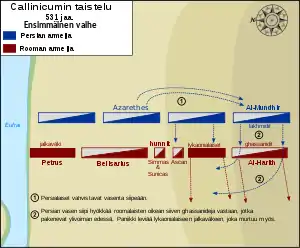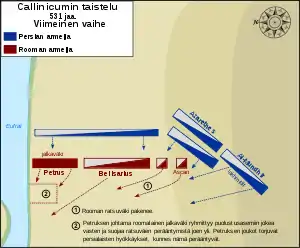Battle of Callinicum
The Battle of Callinicum took place on Easter Saturday, 19 April 531 CE, between the armies of the Byzantine Empire under Belisarius and a Sasanian cavalry force under Azarethes. After a defeat at the Battle of Dara, the Sasanians moved to invade Syria in an attempt to turn the tide of the war. Belisarius' rapid response foiled the plan, and his troops pushed the Persians to the edge of Syria through maneuvering before forcing a battle in which the Sasanians proved to be the pyrrhic victors.
| Battle of Callinicum | |||||||||
|---|---|---|---|---|---|---|---|---|---|
| Part of the Iberian War | |||||||||
| |||||||||
| Belligerents | |||||||||
|
Byzantine Empire Ghassanids |
Sasanian Empire Lakhmids | ||||||||
| Commanders and leaders | |||||||||
|
Belisarius Hermogenes Sunicas & Simmas Ascan † Petrus Longinus † Stephanacius † Al-Harith ibn Jabalah Domnentiolus (POW)[4] |
Azarethes Al-Mundhir III ibn al-Nu'man | ||||||||
| Strength | |||||||||
|
| ||||||||
| Casualties and losses | |||||||||
| Heavy | Heavy | ||||||||
Prelude
In April 531 CE, the Persian king Kavadh I sent an army under Azarethes, consisting of a cavalry force numbering about 15,000 Aswaran with an additional group of 5,000 Lakhmid Arab cavalry[8] under Al-Mundhir, to start a campaign, this time not through the heavily fortified frontier cities of Mesopotamia, but through the less conventional but also less defended route in Commagene[10] in order to capture Syrian cities like Antioch.
The Persian army crossed the frontier at Circesium on the Euphrates and marched north. As they neared Callinicum, Belisarius, who commanded the Byzantine army, set out to follow them as they advanced westwards. Belisarius' forces consisted of about 5,000 men and another 3,000 Ghassanid Arab allies, for the remainder of his army had been left to secure Dara. The Byzantines finally blocked the Persian advance at Chalcis, where reinforcements under Hermogenes also arrived, bringing the Byzantine force to some 20,000 men. The Persians were forced to withdraw, and the Byzantines followed them east.
The battle would occur on Easter Sunday, and the convention at the time was to fast on the day and well into the night. Due to this, if Belisarius were to give battle he would have to fight using inevitably hungry troops.[11] Azarethes sent a message to Belisarius asking to honor the fast for the sake of the Christians and Jews in his army, as well as the Christian forces of Belisarius himself. Belisarius was willing to agree[4] and originally intended to drive off the Persians without a risky battle. The Byzantine troops, however, were restless and anxious, and had become over-confident after their recent victories at Dara and Stala, and clamored for battle. After failing to convince his men, and realizing they would not fight, and possibly mutiny unless he agreed,[12] Belisarius prepared his force for battle.
Deployment
Belisarius anchored his left flank, composed of the Byzantine infantry under command of Jusitinian's bodyguard Peter, on the Euphrates. His center was composed of his cavalry. The right flank was composed of the Ghasanid cavalry.[13] Unlike his deployment at Dara (530), he concentrated his best cavalry in the center and infantry on the wings, possibly because he anticipated the infantry and Ghassanid cavalry may turn to flight.[14]
Azarethes's deployment was similar; his left flank was composed of Lakhmid cavalry under al-Mundhir and corresponded to the Ghassanid section of his opposing force, while his own cavalry was in the center.[13][14]
The two armies met outside Callinicum on 19 April 531 CE. Both armies formed up differently, Belisarius again choosing an "odd" formation that confused his opposing general. In this case he anchored his left flank on the bank of the river with heavy Byzantine infantry, to their right the army's centre, all of the Byzantine cavalry, many of which were cataphracts under the command of Ascan. Linking the centre to the Byzantine right was a detachment of Lycaonian and/or Isaurian infantry (under Stephanacius and Longinus), positioned such that their right was anchored on a rising slope occupied by the army's right wing, which consisted of the 5,000 Ghassanid allies. Belisarius himself took up position in the centre of his deployment.
Āzārethes, who was an "exceptionally able warrior" according to Byzantine historian and chronicler Procopius, chose a much more conventional deployment by dividing his army into three equal parts with the Lakhmid allies under Al-Mundhir's command constituting the left wing such that they corresponded to the Ghassanid section of the Byzantine army. It is possible that he also held an elite tactical reserve behind his divisions of Persian Savārān.
Battle


The battle began with extensive exchange of arrow shots,[15] with Procopius noting the rapidness of the Persian archery. This difference in archery is also mentioned Strategikon of Maurice, who advises to close in with the Persians without any delay.[13] This, combined with a westerly wind, caused the Byzantine side to suffer more casualties at this stage.[14] According to Ian Hughes, however, the casualties were balanced due to the greater penetrative force of Byzantine archery.[15]
Later, after "two-thirds of the day" had elapsed, Azarethes found a weak spot in the Byzantine force and redeployed some of his cavalry to his left wing; this was a similar tactic used at Dara (530), where the Persians tried to find a weak spot and overwhelm it by creating local superiority in that spot. This maneuver was unobserved by Belisarius and proved to be a turning point. The Ghassanids were routed off the field with such ease as to later inspire accusations of treachery. This exposed the right flank of the Lycaonian infantry, who were no match for the Persian cavalry and were routed, while their commanders were killed. Ascan's heavy cavalry was now exposed and showed some resistance, but he was killed and his force was defeated too.[15]
The Persian cavalry and their Lakhmid allies were now placed upon the rising ground looking down on the rest of the Byzantine force. As the rest of the Byzantine cavalry fled and Belisarius failed to reform his line, the Byzantine infantrymen found themselves pressed against the river. The formed a U-shaped phoulkon (fulcum) formation to defend against the missile attacks, with the top of the "U" being closed by the river and foot-archers at the center of the "U" firing supporting arrow shots at the attacking forces, withstanding the Persian attacks until nightfall when they safely escaped across the river to Callinicum.[15] Apparently, repeated charges by the Persian cavalry did not result in much more than mounting casualties on both sides.
The primary sources reporting this phase of the battle are confusing. According to Procopius, Belisarius dismounted and fought alongside the infantry until nightfall, while Malalas reports that Belisarius had fled using a boat earlier, while Sunnicas and Simmas dismounted and fought alongside the infantry. According to Hughes argues the latter to be more probable.[15][16]
Zacharias of Mytilene said of the battle: "[The Romans] turned and fled before the Persian attack. Many fell into the Euphrates and were drowned, and others were killed."[17] However, it is unknown what stage of the battle Zachariah was referring to.
The factuality of Procopius's description of the events in this battle has been questioned.[15] Both Procopius and Malalas provide a detailed description of the events, but their emphasis is different: Procopius emphasizes Belisarius' success in preventing a rout and the losses in Sasanian forces, while Malalas emphasizes Belisarius' early fleeing from the battlefield, noting that the successful prevention of the rout was led by Sunicas and Simmas. Both accounts agree on the poor performance of the Lycoaninan infantry and possible treachery on part of the Ghassanids.[4]
Aftermath
The Byzantine defeat wiped out the benefits of the victory at Dara (530) and gave the initiative once again to the Persians.[15] The strategic outcome of the battle was something of a stalemate; the Byzantine army had lost many soldiers and would not be in fighting condition for months, but the Persian army had taken such heavy losses that it was useless as to its original purpose, the invasion of Syria.
Following the battle, an inquiry against Belisarius was held under Constantoilus due to the defeats at Thannuris and Callinicum. Belisarius blamed the troops for their impetuous urge to engage in battle in Callinicum and thus was cleared from the blame, but was recalled from his position of magister militum per Orientem and was recalled by Emperor Justinian I in Constantinople.[15]
Emperor Kavadh I removed General Āzārethes from command and stripped him of his honors, as the casualties were high.
This mutual disaster was the first of Emperor Justinian's series of (relatively) unsuccessful wars against Sassanids, which led Byzantium to pay heavy tributes in exchange for a peace treaty and the remaining Byzantine land still in Persian hands.
Callinicum ended the first of Belisarius' Persian campaigns, returning all of the land lost to them to Byzantine rule under Justinian I in the Eternal Peace agreement signed in summer 532 CE.
See also
References
- The Empire at War, A.D. Lee, The Cambridge Companion to the Age of Justinian, ed. Michael Maas, (Cambridge University Press, 2005), 122.
- Rawlinson, George (1876). The Seventh Great Oriental Monarchy: Geography, History, and Antiquities of the Sassanian Or New Persian Empire. Longmans, Green. p. 374-376.
- Hughes, Ian (Historian) (2009). Belisarius : the last Roman general. Yardley, Pa.: Westholme. pp. Chapter 4 Section: The Battle of Callinicum. ISBN 978-1-59416-085-1. OCLC 294885267.
- Greatrex, Geoffrey; Lieu, Samuel N. C. (2002). The Roman eastern frontier and the Persian Wars. Part II, AD 363-630 : a narrative sourcebook. London: Routledge. p. 92-93. ISBN 0-415-14687-9.
- Quraysh and the Roman Army: Making Sense of the Meccan Leather Trade, Patricia Crone, Bulletin of the School of Oriental and African Studies, University of London Vol. 70, No. 1 (2007), 73.
- Hughes, Ian (Historian). Belisarius : the last Roman general. Barnsley. ISBN 9781473822979. OCLC 903161296.
- Hughes, Ian (Historian). Belisarius : the last Roman general. Barnsley. ISBN 9781473822979. OCLC 903161296.
- Geoffrey Greatrex and Samuel N.C. Lieu, The Roman Eastern Frontier and the Persian Wars Ad 363-628, Part 2, (Routledge, 2002), 92.
- According to Zacharias, just before the battle begins, the Romans found the Sasanians like a "little flock".
- Hughes, Ian (Historian). Belisarius : the last Roman general. Barnsley. ISBN 9781473822979. OCLC 903161296.
- Caesarea, Procopius (2018). History of the Wars. Seltzer Books. p. 86. ISBN 9781455407699.
- Brogna, Anthony (1995). The Generalship Of Belisarius. Hauraki Publishing.
- Elton, Hugh (2018). The Roman Empire in Late Antiquity: A Political and Military History. Cambridge University Press. p. 327. ISBN 978-0-521-89931-4.
- Rome and Persia at War, 502-532. Francis Cairns. 1998. p. 202. ISBN 978-0-905205-93-9.
- Hughes, Ian (2009). Belisarius: The Last Roman General. Pen and Sword. p. 55-59. ISBN 978-1-84468-941-5.
- Cameron, Averil (January 1985). Procopius and the Sixth Century. ISBN 9780520055179.
- Historia IX.4,95.4-95.26
Sources
- Greatrex, Geoffrey; Lieu, Samuel N. C. (2002), The Roman Eastern Frontier and the Persian Wars (Part II, 363–630 AD), Routledge, ISBN 0-415-14687-9
- Martindale, John R.; Jones, A.H.M.; Morris, John (1992), The Prosopography of the Later Roman Empire – Volume III, AD 527–641, Cambridge University Press, ISBN 0-521-20160-8
- Shahîd, Irfan (1995). Byzantium and the Arabs in the sixth century, Volume 1. Dumbarton Oaks. ISBN 978-0-88402-214-5.
- Stanhope, Phillip Henry (1829). The Life of Belisarius. Bradbury and Evans Printers.